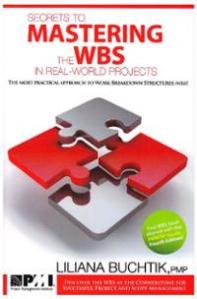Secrets to mastering the WBS in real world projects is by Liliana Buchtik PMP and was published by the Project Management Institute (PMI) in 2010. Liliana Buchtik is president of Buchtik Global, a consulting and training firm specialising in project management.
The book is written in a simple question and answer format and each chapter heading is phrased as a question. There are 12 chapters covering all aspects of the construction and use of the Work Breakdown Structure (WBS) in this 202 page paperback book.
Chapter 1 sets the scene by providing a definition of the WBS as “a structure used to breakdown or divide the project work” to show what the project has to deliver to achieve the desired outcome.
Chapter 2 advances 20 potential benefits that can be obtained by implementing a WBS. These range from understanding the work through to inspiring confidence and gaining credibility.
Chapter 3 explains 4 areas of confusion about the WBS. These being confusing the WBS with a sequence of work, confusing the WBS with a schedule, confusing the WBS with the organisational breakdown structure (OBS) and not using the modern working definition of the WBS. The author takes time on the final point to explain the difference between a task and deliverable based structure.
Chapter 4 asks what questions need to be asked to understand the capability of a well structured WBS. The chapter asks the what, when, why, who and how questions that relate to the creation of the WBS.
Chapter 5 covers the theoretical requirements of creating a WBS. This includes how many levels the WBS should go to and identification and numbering of the individual elements. One of the key aspects of this chapter is answering the question of how many levels are needed in the WBS. The author suggests that you should “decompose the WBS to the level where you are able to manage the work and able to assign and estimate resources, costs and time”.
Chapter 6 covers the practical steps needed to create a WBS that aids project delivery. The author walks the reader through a 20 step model to create the WBS. This begins with understanding the required inputs and closes with baselining the identified project scope.
Chapter 7 discusses software tools that can be utilised to visually represent the WBS. Visual WBS’s are considered as either being a tree structure , text based outline or a spreadsheet based tabular format. Software such as Microsoft Word, Excel and Visio are covered as is MindManager and others.
Chapter 8 explains how the WBS can be integrated with the management of scope. The author argues that “it’s almost all about scope and how to better manage it. The scope is the basis for planning.” The chapter advances the sensible concept that we must, as project managers, understand the scope of the project and that the WBS is a key pillar in this strategy.
Chapter 9 shows how the WBS can be used to derive resource and cost schedules including why this should be done and offering practical advice on how to do it.
Chapter 10 demonstrates how the project manager can integrate the WBS with stakeholder and risk management. The central thesis of the chapter being that the WBS can be exploited for uses beyond pure scope management.
Chapter 11 and 12 close the book by exploring its use in virtual, multicultural and agile environments.
The book closes with a conclusion and 2 appendices encompassing 2 generic WBS templates.
The book provides an interesting view on the WBS. The author conveys an obvious passion for the subject which draws the reader in. The practical advice is relevant and every project manager should be able to take something from this book and apply it to their project management practice. I recommend this book to any project manager looking to broaden their understanding of this powerful project management process.

